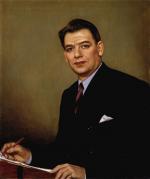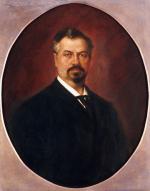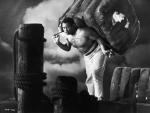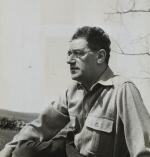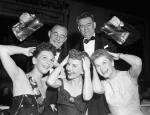![header=[Marker Text] body=[Lyricist and librettist whose collaboration with composer Richard Rodgers transformed the Broadway musical. Their works include <i>South Pacific</i> (1949), <i>The King and I</i> (1951), and <i>The Sound of Music</i> (1959). The bucolic landscape of Hammerstein's nearby farm inspired him to write "Oh, What a Beautiful Morning" for the musical <i>Oklahoma!</i> in 1943.] sign](http://explorepahistory.com/kora/files/1/10/1-A-25A-139-ExplorePAHistory-a0h7x0-a_450.jpg)
Mouse over for marker text
Name:
Oscar Hammerstein II
Region:
Philadelphia and its Countryside/Lehigh Valley
County:
Bucks
Marker Location:
US 202 at East St., Doylestown
Dedication Date:
July 18, 1994
Behind the Marker
More than anything else, Oscar Hammerstein was a storyteller who reconceived musical theater. He gave voice to a long, lyrical soundtrack so populist, so affirming, and so hopeful that it continues to define the American essence from sunrise to sunset. And if his songs gave us beautiful mornings, enchanted evenings, and a remarkable share of happy talk in between, that's not to say that Hammerstein filtered his work solely through cockeyed, optimistic rose-colored glasses. Quite the opposite, his work tackled head-on the prejudices of race and class and hatred, encouraging us all to keep our heads high and not fear the dark - both the darkness imposed on us and the ones we carry within.
Oscar Greeley Glendenning Hammerstein II was born to a life in the theater, though he tried fighting what was ultimately inevitable. His grandfather, Oscar was an important New York opera impresario who also owned a popular vaudeville house that his sons, Arthur and Oscar Jr.'s father, William, managed. Born in Manhattan on July 12, 1895, young Oscar grew up hanging out backstage, but after finishing military school, entered Columbia University resolved that his future lay in law.
The theater, however, lurked in his shadows. At Columbia, he wrote and acted in several musical revues, even, as a law student, supplying the words to a few tunes penned by a freshman named Richard Rodgers, whose life would intersect Hammerstein's a quarter century later. In his second year of law school, Hammerstein earned extra cash serving summonses for a law firm; denied a raise, he simply quit - the firm and the law - and went right to work, in 1917, for his uncle Arthur as an assistant stage manager.
For the next decade, Hammerstein honed his craft as a writer, often in tandem with his mentor, the famed lyricist Otto Harbach, collaborating with the likes of composers Rudolf Friml, Jerome Kern, and Sigmund Romberg to produce such light-hearted musical hits as "Rose Marie," "Sunny," and "Desert Song." Hammerstein and Harbach wrote several standards together for those shows - including "The Desert Song" and "The Indian Love Call" - but nothing that presaged the lyrical and storytelling firepower Hammerstein was about to unleash.
No one had ever seen anything like Show Boat when the groundbreaking musical opened on Broadway in 1927. For starters, the underlying story, adapted by Hammerstein from Edna Ferber's novel, was serious, raising socially complex questions about race and miscegenation. Musicals, until then, were confections really; their themes insubstantial and the stories and music supporting them helium-filled. Not "Show Boat." Working alone with Kern, Hammerstein radically recast the conventions of the musical play to create an instant and enduring classic, a work of immense ambition that many critics continue to consider the crowning glory of the American musical. Gone were the chorus girls and slapstick humor and the songs and dances that were just songs and dances. Instead, Hammerstein replaced them with real characters and songs that drove the narrative line.
Together with Kern, Hammerstein worked to integrate songs - and comedy - into the story to advance the plot, not stop it. And what songs they wrote: "Can't Help Lovin" Dat Man," "Make Believe," and "Ol" Man River," the last of which Paul Robeson, who starred in the first movie version, would ultimately raise over decades of performance from a plaintive folk hymn into a defiant anthem of black pride and protest.
Paul Robeson, who starred in the first movie version, would ultimately raise over decades of performance from a plaintive folk hymn into a defiant anthem of black pride and protest.
So, how do you follow up on that? Hammerstein kept asking himself that question for a decade and a half, and really couldn't find a good answer. He returned to writing operettas and light musicals, most quite successful, but nothing with the heft and immortality of Show Boat. By the early 1930s, he was working, unhappily and unproductively, in Hollywood, writing musicals that are largely forgotten. He yearned to go back to Broadway. In 1940, Hammerstein and his second wife moved to within 100 miles of his target, to a 40-acre plot in Bucks County called Highland Farm, where he would live and work, standing at a desk overlooking a meadow, for the rest of his life in a creative community that included such writers as George S. Kaufman,
in a creative community that included such writers as George S. Kaufman,  Pearl Buck,
Pearl Buck,  James A. Michener, and Dorothy Parker. His spirits quickly rekindled.
James A. Michener, and Dorothy Parker. His spirits quickly rekindled.
Saddened by Hitler's storming one of the locales he held dearest, Hammerstein wrote the hauntingly beautiful lyrics to "The Last Time I Saw Paris" soon after settling in Buck County. He sent his love poem to the city to Kern, and their song, featured in the movie Lady Be Good, won an Academy Award in 1941.
The following year, Hammerstein returned to Broadway with his audacious updating of Bizet's gypsy opera Carmen. Cast with all-black performers, Carmen Jones allowed him to re-explore the questions of race in America he had raised so daringly in Show Boat. The musical was eventually turned into a movie starring, Dorothy Dandridge - her performance earned her the first Academy Award nomination for a black lead performer.
Then lightning struck. Composer Richard Rogers wanted to convert a novel called Green Grow the Lilacs into a musical, but his regular collaborator, Lorenz Hart, wasn't interested. So, he brought the idea to Hammerstein, and launched the most productive and honored partnership in the history of musical theater. That book turned into 1943"s Oklahoma! soon followed by Carousel (1945) the movie State Fair (1945), 1949"s South Pacific (based on neighbor Michener's award-winning stories of World War II), 1951"s The King and I, 1958"s Flower Drum Song, and 1959"s The Sound of Music. In between there were a few flops, but the overall accomplishment of Rogers and Hammerstein was unprecedented: multiple Tony Awards, an Academy Award (the song "It Might as Well Be Spring" from State Fair), and the Pulitzer Prize for drama for South Pacific, the first musical ever so awarded. There's no greater measure of these musicals' continued success and belovedness than in the frequency of their revivals on Broadway - or how regularly they're mounted on high school stages and in community theaters from coast to coast.
These musicals were built on the obvious foundation of Rodgers's melodies and Hammerstein's lyrics, and while both clearly drove the shows in tandem, there has never been before or since a musical word man on Broadway with the reach of Hammerstein. First, while his lyrics could border on the poetic sublime, they were also simple, even colloquial, their words revealing the essential souls of the characters singing them; that was a Broadway first. Second, he was a man of conviction, and he infused his work with his ideals, using the stage as a platform to preach to audiences about harmony, unity, and the oneness of man: if Oklahoma! and Carousel were his affirmations of the American spirit, South Pacific, The King and I and Flower Drum Song were, like Show Boat years before, pleas, from his American heart, for tolerance. Even Sound of Music, set against a backdrop of the Nazi takeover of Austria, sent out the hopefulness of good triumphant. Hope. It was the message Hammerstein insisted on sending.
There's a story of that message that James Michener liked to tell. After a preview of South Pacific, he was accosted in front of the theater by a friend who loved the show, but hated the song "You've Got to Be Carefully Taught," and suggested Michener use his influence to dump it. Sung by the young Navy lieutenant confused about his romance with a Polynesian girl, the song is about how prejudice is imposed, not inherent, and how we can overcome it. When Michener told Hammerstein, Hammerstein was ecstatic; his song was doing precisely the job he intended: to provoke. It was, Hammerstein told Michener, his whole reason for writing the show.
In his final years, Hammerstein, always a man of honor, repaid his spiritual debt to Otto Harbach by taking on a mentee of his own, a young composer-lyricist named Stephen Sondheim, who, like Hammerstein, would go on to shake up and advance the American musical. On August 23, 1960, after an intense battle with stomach cancer, Hammerstein died at his Bucks County farm. In his honor, the lights both on Broadway and London's West End went dark.
Oscar Greeley Glendenning Hammerstein II was born to a life in the theater, though he tried fighting what was ultimately inevitable. His grandfather, Oscar was an important New York opera impresario who also owned a popular vaudeville house that his sons, Arthur and Oscar Jr.'s father, William, managed. Born in Manhattan on July 12, 1895, young Oscar grew up hanging out backstage, but after finishing military school, entered Columbia University resolved that his future lay in law.
The theater, however, lurked in his shadows. At Columbia, he wrote and acted in several musical revues, even, as a law student, supplying the words to a few tunes penned by a freshman named Richard Rodgers, whose life would intersect Hammerstein's a quarter century later. In his second year of law school, Hammerstein earned extra cash serving summonses for a law firm; denied a raise, he simply quit - the firm and the law - and went right to work, in 1917, for his uncle Arthur as an assistant stage manager.
For the next decade, Hammerstein honed his craft as a writer, often in tandem with his mentor, the famed lyricist Otto Harbach, collaborating with the likes of composers Rudolf Friml, Jerome Kern, and Sigmund Romberg to produce such light-hearted musical hits as "Rose Marie," "Sunny," and "Desert Song." Hammerstein and Harbach wrote several standards together for those shows - including "The Desert Song" and "The Indian Love Call" - but nothing that presaged the lyrical and storytelling firepower Hammerstein was about to unleash.
No one had ever seen anything like Show Boat when the groundbreaking musical opened on Broadway in 1927. For starters, the underlying story, adapted by Hammerstein from Edna Ferber's novel, was serious, raising socially complex questions about race and miscegenation. Musicals, until then, were confections really; their themes insubstantial and the stories and music supporting them helium-filled. Not "Show Boat." Working alone with Kern, Hammerstein radically recast the conventions of the musical play to create an instant and enduring classic, a work of immense ambition that many critics continue to consider the crowning glory of the American musical. Gone were the chorus girls and slapstick humor and the songs and dances that were just songs and dances. Instead, Hammerstein replaced them with real characters and songs that drove the narrative line.
Together with Kern, Hammerstein worked to integrate songs - and comedy - into the story to advance the plot, not stop it. And what songs they wrote: "Can't Help Lovin" Dat Man," "Make Believe," and "Ol" Man River," the last of which
So, how do you follow up on that? Hammerstein kept asking himself that question for a decade and a half, and really couldn't find a good answer. He returned to writing operettas and light musicals, most quite successful, but nothing with the heft and immortality of Show Boat. By the early 1930s, he was working, unhappily and unproductively, in Hollywood, writing musicals that are largely forgotten. He yearned to go back to Broadway. In 1940, Hammerstein and his second wife moved to within 100 miles of his target, to a 40-acre plot in Bucks County called Highland Farm, where he would live and work, standing at a desk overlooking a meadow, for the rest of his life
Saddened by Hitler's storming one of the locales he held dearest, Hammerstein wrote the hauntingly beautiful lyrics to "The Last Time I Saw Paris" soon after settling in Buck County. He sent his love poem to the city to Kern, and their song, featured in the movie Lady Be Good, won an Academy Award in 1941.
The following year, Hammerstein returned to Broadway with his audacious updating of Bizet's gypsy opera Carmen. Cast with all-black performers, Carmen Jones allowed him to re-explore the questions of race in America he had raised so daringly in Show Boat. The musical was eventually turned into a movie starring, Dorothy Dandridge - her performance earned her the first Academy Award nomination for a black lead performer.
Then lightning struck. Composer Richard Rogers wanted to convert a novel called Green Grow the Lilacs into a musical, but his regular collaborator, Lorenz Hart, wasn't interested. So, he brought the idea to Hammerstein, and launched the most productive and honored partnership in the history of musical theater. That book turned into 1943"s Oklahoma! soon followed by Carousel (1945) the movie State Fair (1945), 1949"s South Pacific (based on neighbor Michener's award-winning stories of World War II), 1951"s The King and I, 1958"s Flower Drum Song, and 1959"s The Sound of Music. In between there were a few flops, but the overall accomplishment of Rogers and Hammerstein was unprecedented: multiple Tony Awards, an Academy Award (the song "It Might as Well Be Spring" from State Fair), and the Pulitzer Prize for drama for South Pacific, the first musical ever so awarded. There's no greater measure of these musicals' continued success and belovedness than in the frequency of their revivals on Broadway - or how regularly they're mounted on high school stages and in community theaters from coast to coast.
These musicals were built on the obvious foundation of Rodgers's melodies and Hammerstein's lyrics, and while both clearly drove the shows in tandem, there has never been before or since a musical word man on Broadway with the reach of Hammerstein. First, while his lyrics could border on the poetic sublime, they were also simple, even colloquial, their words revealing the essential souls of the characters singing them; that was a Broadway first. Second, he was a man of conviction, and he infused his work with his ideals, using the stage as a platform to preach to audiences about harmony, unity, and the oneness of man: if Oklahoma! and Carousel were his affirmations of the American spirit, South Pacific, The King and I and Flower Drum Song were, like Show Boat years before, pleas, from his American heart, for tolerance. Even Sound of Music, set against a backdrop of the Nazi takeover of Austria, sent out the hopefulness of good triumphant. Hope. It was the message Hammerstein insisted on sending.
There's a story of that message that James Michener liked to tell. After a preview of South Pacific, he was accosted in front of the theater by a friend who loved the show, but hated the song "You've Got to Be Carefully Taught," and suggested Michener use his influence to dump it. Sung by the young Navy lieutenant confused about his romance with a Polynesian girl, the song is about how prejudice is imposed, not inherent, and how we can overcome it. When Michener told Hammerstein, Hammerstein was ecstatic; his song was doing precisely the job he intended: to provoke. It was, Hammerstein told Michener, his whole reason for writing the show.
In his final years, Hammerstein, always a man of honor, repaid his spiritual debt to Otto Harbach by taking on a mentee of his own, a young composer-lyricist named Stephen Sondheim, who, like Hammerstein, would go on to shake up and advance the American musical. On August 23, 1960, after an intense battle with stomach cancer, Hammerstein died at his Bucks County farm. In his honor, the lights both on Broadway and London's West End went dark.




